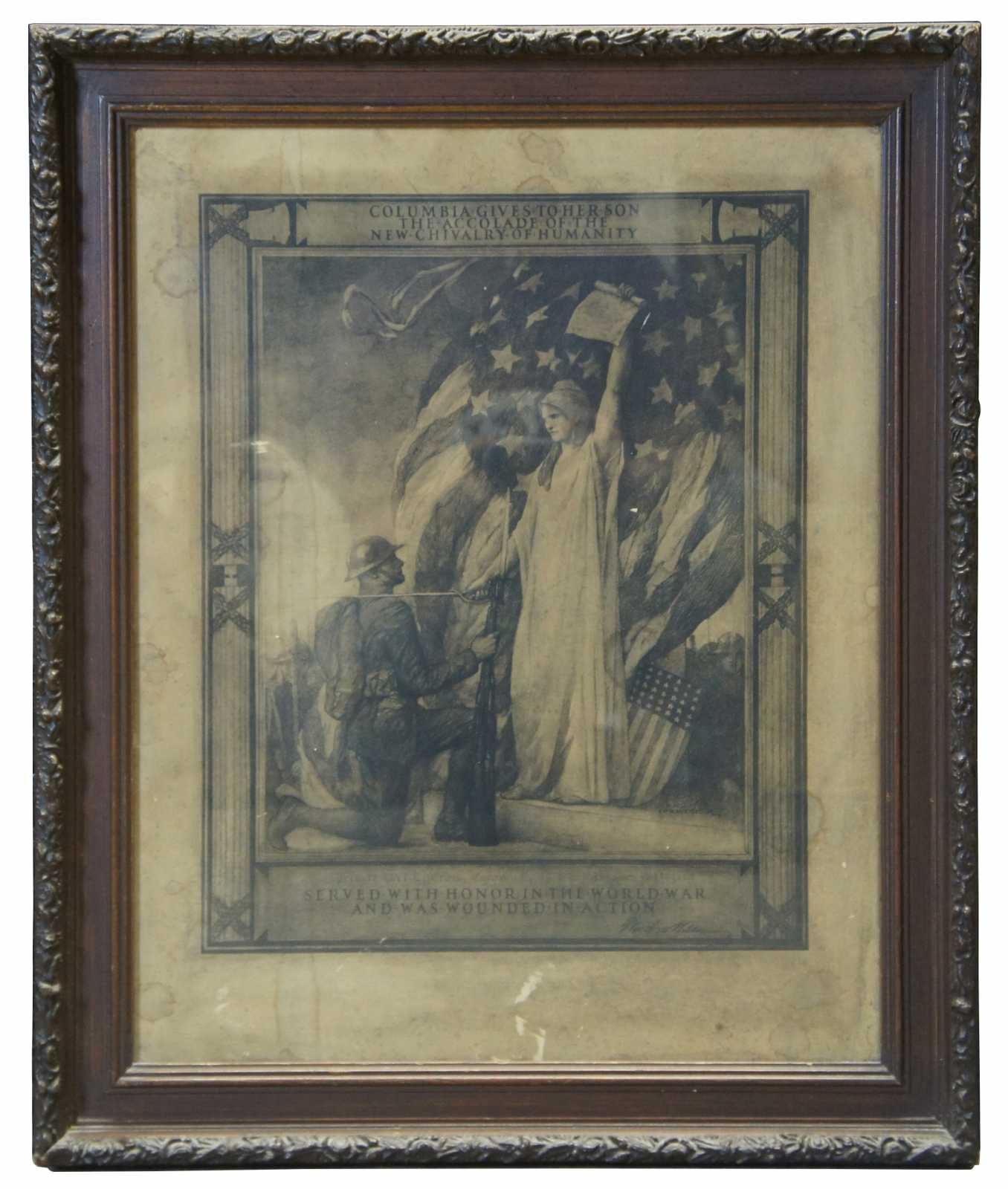
Shipping:
Free Shipping Included
Delivery:
Estimated 2-15 Business Days
Payments:
Credit Card, Check, Cash, PayPal, Apple Pay, Venmo
Returns:
30 Days 100% Money Back Guarantee, Buyer Pays Return Shipping
Description
World War I memorial print designed by E.H. Blashfield 1919, produced to honor the men who fought in the First World War and signed in plate by President Woodrow Wilson. This one is personalized for Private Earl E. Cross. “A native New Yorker, Edwin Howland Blashfield (1848-1936) was a mural and genre easel painter in conservative style, who was especially noted in his mural work for coordinating with architects so that his work fit the overall vision for its setting. Trained in the academic tradition in Europe and America, he rose to national prominence at age forty-five during the 1893 Chicago World's Fair Exposition for his mural, ""The Art of Metal Working"". It was a series of utilitarian-theme paintings that were installed in the eight domes of the Manufactures and Liberal Arts Building, the largest structure at the Exposition.
After the success of this commission, Blashfield devoted himself almost exclusively to mural painting, which was experiencing a revival during that period known as the American Renaissance. It was a time of prosperity when many architects were designing large private homes, and public buildings whose decoration included murals with laudatory themes of the work ethic and associated virtues that created the prosperity.
Blashfield's commissions included the dome of the Library of Congress, Detroit Public Library, Union League Club of Chicago, Court House of Baltimore, Cleveland Federal building, and capitol buildings of Iowa, Wisconsin and Minnesota. He also did murals for many churches such as the Church of the Ascension in New York City and St. Matthew's Church in Washington DC.
Active in numerous cultural organizations, Blashfield was President of the National Academy of Design in New York from 1920 to 1926 and a member of the Architectural League of New York, the National Sculpture Society and the National Society of Mural Painters. Exhibition venues for easel painting were extensive and included the National Academy of Design, Paris Salon, Brooklyn Art Association, Pennsylvania Academy, and the Royal Academy in London.
In 1913, Blashfield's book, ""Mural Painting in America"" was published, which was a compilation of his lectures at the Art Institute of Chicago and reflected his verbal eloquence as a champion of mural painting. He made it clear that mural painting was distinctly different from easel painting in that easel painting was quite often intended only to convey aesthetic beauty but that murals went beyond aesthetic focus to teach lessons about patriotism, morality and historical roots. In other words, murals incorporated aesthetics to convey utilitarian themes.
As an easel painter, Blashfield did subjects including genre, portraits, ancient ruins and Indian figures. He developed a distinctive format that placed both real and allegorical figures in settings of historical and moral themes. Much of Blashfield's earlier works included historical genre costume pieces that demonstrate his interest in dress and furnishings. In both easel paintings and his murals, Blashfield proceeded from careful black-and-white studies to finished oils on canvas. He often used a frieze-like format for his classically beautiful women, whom he depicted with elegant line and rich, inventive color. For murals, his working technique was to complete the work on canvas, and then mount the canvas on the wall, which meant he could work in his own studio until the work was ready for installation.
Blashfield was born in New York in 1948. He studied in Boston briefly in the mid 1860's with Thomas Johnston and William Rimmer. From 1867 to 1870 and 1874 to 1880, he was in Paris where his studies included the private atelier of Leon Bonnat and close association with Jean-Leon Gerome, who was a prominent historical genre painter and teacher at the Academy Julian. During this period, he also was in Germany, Italy and Switzerland.
Upon returning to the United States, Blashfield took up residence in the Sherwood Studio Building in New York from 1881-87. Then he left for six more years of travel, which included Egypt, Europe and England. He spent the summer of 1887 at the artist colony at Broadway, England and associated with American painters Edwin Austin Abbey, Frederick Leighton and Lawrence Alma-Tadema.
Edwin Blashfield died in 1936. Of him it was written: ""Along with William Morris Hunt and John LaFarge, Blashfield was one of the most prolific and important of the American mural painters."" (Falk, 344)”
Condition
Good Overall - Print yellowed/stained/some tears; gentle wear to frame; see pictures
Dimensions
19.5” x 1.25” x 23.5” / Sans Frame - 15.5” x 19.5” (Width x Depth x Height)